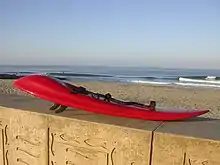Waveski
The Waveski, previously known as the "Paddle Ski” is a surfboard where the rider 'sits' on top of the surfboard. Waveski surfing is a dynamic sport combining paddle power with the manoeuvrability and performance of a surfboard. A Waveski resembles a larger volume surfboard, with the addition of a hollowed out seat with seat belt, foot straps and double ended paddle enabling the rider to remain attached to the board for maneuvers and to 'Eskimo roll' if overturned. The waveski rider or surfer uses a double-ended paddle while seated. To turn the rider uses his weight to lean on the side rails and paddle to pivot or propel the board up the wave. The sport is categorized under the International Canoe Federation.[1] The discipline holds biennial World championship events, the next of which will be held at the Nahoon Reef, outside the town of East London, South Africa.

History
The history of Waveski is not as well documented as standup or bodyboarding. It is known that Peruvian fisherman surfed their wicker boats to the shore with their catch. There are also documented accounts by Captain Cook of sightings of Polynesians riding waves on dugout and outrigger canoes. In more modern times, Australian and South African Lifeguards used two man sit on top "ski's" as rescue boats at beaches. They could patrol the surf zone with these craft and drag distressed swimmers or surfers back to shore quickly on the ski. In North America, Danny Broadhurst, a surfer from Long Island, created some early waveskis in the 1970s, although these were heavy, bulky and not particularly maneuverable. The sport experienced its major growth in the 1980s with manufacturers in South Africa, Australia and USA. Original boards had wooden frames covered in glass fibre then molded 'Pop=Out' molded hollow boards which evolved to foam injected and followed by custom hand made boards were being shaped and glassed out of polystyrene foam and epoxy resins. Contemporary boards are shaped in precision CNC machines and weigh around 6 kilograms (13 lb) when completed.[2]
Description
Many of the manoeuvres waveskiers have been performing since the 1980s are only now becoming mainstream moves in surfing, where they were mocked in days gone by surfers. Manoeuvers such as aerials, flip aerials, 360's and various other radical moves stemming from freestyle white water kayaking are all mainstream in the professional waveski surfing community. The sport is experiencing a growth in countries such as Brazil and France tying in with the river and sea kayak sports and holding joint competitions as they share a common functionality. Competitions are similar to stand up surfing ones and are judged on the performance of the rider on the waves within a 20-minute heat.
Equipment
High performance waveskis weigh 6–8 kilograms (13–18 lb) and are custom made, either via traditional foam shaping or CNC routing of an EPS foam blank that is finished in either glass, carbon, carbon kevlar or mixes of the aforementioned cloth bonded by using epoxy resin. This manufacturing technique is time consuming but makes the waveski light and strong. Waveskis are designed for surfing ocean waves and therefore design features that apply to surf boards also apply to waveski's.
The paddle is the other important component in Waveski surfing. Not only does the paddle provide the motive force to propel the waveski but it is also used in the manoeuvering and control of the waveski at all times. Paddles range in length from around 1.75m (for cadets) long to nearly 2.0m long for taller waveskiers. The length of paddle chosen by the surfer is highly personal as is the degree of offset between the blades. Offset can vary from 90° to 0° and are available for left or right hand dominant waveski surfers. Choice of paddle material and construction differs from other paddle sports in that waveski surfers tend to want more bouyany paddle blades in order to lean more on the blade during hard turns. The buoyant blade also aids stability while paddling these narrow surf craft out through the waves.
See also
References
- "Waveski Surfing". International Canoe Federation. 14 June 2018.
- Kotzé, Naudé. "History of Waveski Surfing". Waveski Adventurers.